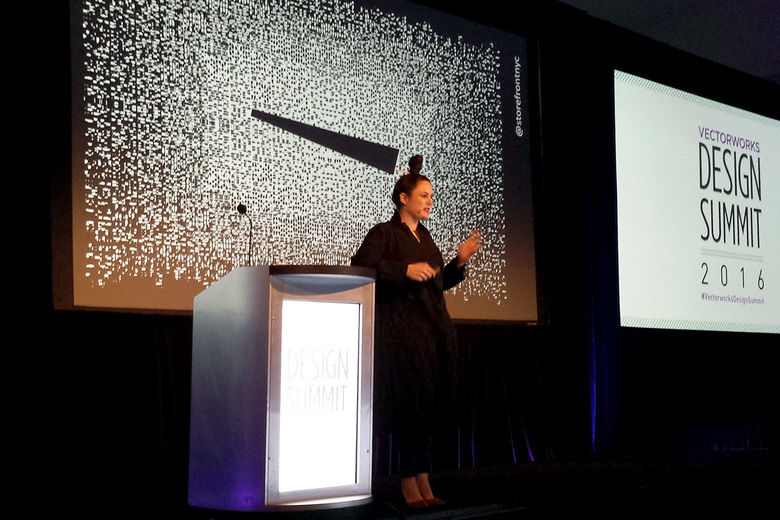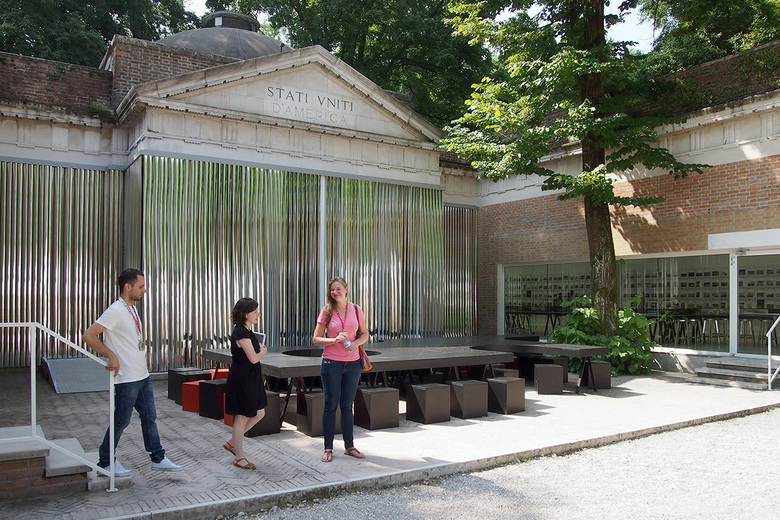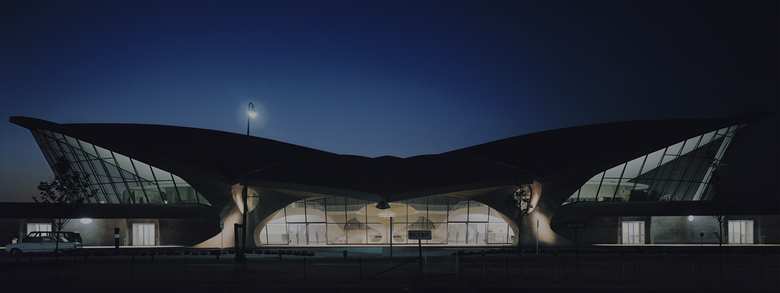Vectorworks Design Summit
Outside Your Comfort Zone: Eva Franch i Gilabert at the Summit
Last week Eva Franch i Gilabert, Chief Curator and Executive Director of the Storefront for Art and Architecture in New York, gave the keynote address at the Vectorworks Design Summit in Chicago. World-Architects editor John Hill spoke with Franch after her talk to find out more about some of her initiatives.
In her 70-minute, rapid-fire talk, Franch barreled through the bevy of exhibitions, publications, competitions, events, parties, websites, and even TV broadcasts that she has organized at the Storefront for Art and Architecture since taking the institution's helm in 2010. It was an invigorating talk that woke up the 600-plus throng of Summit attendees in the crowd and asked them to go beyond their comfort zones. In the first half of the talk Franch focused on OfficeUS, a long-term project geared to producing a "new space of architectural practice"; it began as the US pavilion at the 2014 Venice Architecture Biennale and will soon see the publication of the third of four planned books. Franch then moved on to the numerous other Storefront undertakings, a couple of which I asked her about after the keynote. An edited transcript of our conversation follows.
John Hill: In the keynote you spoke about the Storefront International Series, which had its first iteration in the Dominic Republic in 2013 and that Vectorworks sponsored. Can you say more about that series, particularly in regard to how the Storefront has broken out of the confines of its triangular space on Kenmare Street?
Eva Franch i Gilabert: With Joseph Grima before me and Sarah Herda before him, Storefront has always had a presence in other places, because other people who understood the mission of Storefront wanted to have a piece of it or the spirit of it in their own context. So Joseph started a project called "Postopolis" that brought people in the blogosphere, as that space was emerging, in direct conversation with individuals in different cities. You participated in the ones in New York and Los Angeles, I believe.
Yes, in New York.
I was part of the one in Mexico City, and most interesting were the conversations that took place after the talks. The talks were talks and there was no real interaction, and all the time we were inside a space, the Museo Experimental El Eco. I remember hearing a demonstration outside, so I left the space and followed those people for three hours to try and figure out was going on, what they were protesting, what was happening. And going through the city I realized that if Storefront goes elsewhere it should engage with the city rather than being in a space.
Rubén Hernández Fontana and Sachi Hoshikawa, an architect and developer based in New York City, said they wanted to bring Storefront to the Dominican Republic. I didn’t know exactly how I wanted to do it, but I knew I didn’t want to just go and do an event. We were offered the auditorium in City Hall and I said, “No. No. No.” I asked Sachi, “What can we talk about there that we can’t talk about anywhere else?” It was a very easy exercise. We produced an Excel sheet with four columns: one with interesting sites that were unresolved; the second with contested issues that concern society; the third with the names of experts and individuals who we thought were important in the local context; and finally a list of global experts – critics and writers but also practitioners and people who could resonate with the issues and sites. So we looked at this matrix and started to find alliances and threads, and we produced a series of events ["Storefront IS DR"]: nine events that developed over the course of six days.
We started on one end of the island, in Punta Cana where all of the resorts are. Working with Sachi and Rubén we found this contested site – it’s a car wash but also a hairdresser, a brothel, many things. I said, “We need to go there.” So we talked to the owner and told him what we were doing, and that’s how the first event happened. From there we moved to different locations, really having incredible conversations.
We had one [conversation] trying to talk about the idea of what it means to innovate, held at the Pinewood Indomina Studios. They are located where the line of the sea and the sky is the closest more days of the year than anywhere else; it’s like that Spanish song about the blue of sky and the blue of the sea, where they seem to be the same – a very romantic song. Because of the light and reflection, they found this opportunity, so movies like Pirates of the Caribbean have been made in this secret location. So the idea is really trying to understand what a territory wants to be. Like Kahn asked, “What does a brick want to be?” one should look into a place and ask, “What does this place want to be?” So for that location, we brought filmmakers and visual artists to discuss what the DR has that no other culture has.
The event that we had on infrastructure, I wanted to do it in one of the favelas in Santo Domingo that does not have electricity. We invited the deputy mayor in charge of infrastructure, and he was insisting that we have the event in city hall, giving us the auditorium. He told me, “We can not do the event in that area; that is not a safe place.” So I said, “We are going to have the event there. If you want to come, come; if not, you don’t.” So the guy came with his bodyguards! For them it was a real operation to be there. And Sachi said to us, “You do not know how important it is that you come here with your cultural leverage and you push us outside of our comfort zone.” I think this is what Storefront is able to do when we go elsewhere. We are able to use that reputation, if you will, to try to break some of the conventions and bring people together that might not otherwise. That was only possible because Rubén was good friends with the CEO of Vectorworks, so they provided support for the first iteration of one of the most interesting initiatives that the Storefront is producing. We did the second one in Lisbon, and we hope to continue it in other locations.
I’m probably not alone in knowing very little about what is going on in the Dominican Republic, so I think it would be great if, like OfficeUS, there were a publication on the DR events. Are there plans to do so, to broaden the impact of what you did there?
With the Storefront International Series, we did have everything recorded, and we asked all of the participants to write a report. We could do a book with that material; we just need an editor who would want to take on the work of distilling all of the conversations and making it happen. It’s a question of time and resources that we don’t have. The truth is the series of conversations that happened are very important ones, yet at the Storefront we have limitations. We do hope that somebody will come later on and take the events elsewhere. As I always say, “Ideas are for free” – and we generate a lot of them. We always hope that someone can take them and make them happen.
On May 8th the Storefront’s Spring Benefit is being held in Eero Saarinen’s TWA Terminal at JFK, under the theme “Beyond Borders.” Can you speak about the theme and the venue? In the case of the latter, it seems that the Storefront selects locations of some historical importance, such as the Four Seasons in 2010, the first one I attended.
That was my second, and that was the year I was appointed. It was a very interesting night for me. Storefront did not have a benefit until about ten years ago. Just this last week I was looking into the history of benefits, and it’s a very interesting thing if you realize how all of the cultural institutions now have their own benefits. It’s a very American thing. The first thing I could trace was all the way back to after the First World War in Vienna, actually, where they did a gala to benefit the soldiers. And that moved into the US with charity. Over the last few years benefits have become the tool by which cultural organizations raise the necessary funds to keep their programs running. It’s an interesting phenomenon; it’s like the “spirit of the time” in some way.
As you saw in the talk, I like to think that every single thing that the Storefront does is done in the Storefront way. So this idea of just doing an event to raise funds, to write a speech and do it anyplace doesn’t make it for me. I like to do everything we do with the same spirit and core. The benefit raises something like 40% of our annual budget, so it is essential for us to keep doing what we do. Benefits over the years became very clearly a space by which the Storefront community can come together in a way that we can celebrate what we do and who we are.
The first benefit I had my hands on was the one we did at the Woolworth Building [in 2012], honoring Bernard Tschumi and Barbara Kruger. Of course we had the theme of “Red/Rad”… the idea of being very close to the people we’re honoring and understanding where they come from and what kind of contribution they have made. That year we also brought Jimenez Lai to make an installation in the vault, and we painted the building in red lights. So there was a clear understanding to make an event – a party, ultimately – that also brings in some of the ideas at the forefront.
From there we went to the Beekman Palace just across from the Woolworth Building –
A lot of these spaces are being transformed. (Woolworth was converted to condos, the Four Seasons closed recently and its furnishings are being auctioned off, and Beekman Palace was turned into a hotel, the same of which will happen to the TWA Terminal.)
Yea, and that one was incredible. There are always layers that go into those themes. That year was the 30th anniversary of the Storefront, so we reflected on many of the issues that Storefront had been addressing over that time. We commissioned a piece from Vito Acconci (who co-designed the Storefront façade with Steven Holl) to talk about every single project in the history of the institution; it’s a voice recording of about five hours – it’s incredible. Even the menu of the event was going way back in history, so all of the dishes were what was cool over those years, ending obviously in kale, since it’s so fashionable. So every single space is taken as a space of design and disruption.
From there we moved to the year of the Venice Biennale [2014] so that was the one year we could not spend much time on it. So we just went to the bank on the Bowery, a building by McKim, Mead & White, one of the offices were dealing with historically with OfficeUS. It made sense: an Italian, Renaissance-inspired building in New York – coming from the place where we were going and the idea of import and export.
Last year we took the idea of “Trans” in a building that was obviously transgressing the skyline that everybody had been worshipping in New York, a building that I think was extremely problematic for many people for many months. Little by little people started loving it as part of the skyline, but still hating it as a space of luxury and manifestation of some of the problems New York City is facing these days: expulsion of low-income people and different creative classes who cannot afford to live in the city. It was fantastic to be in (Rafael Viñoly’s) 432 Park Avenue.
This year is the idea of “Beyond Borders.” Last year we got a grant from the NEA (National Endowment for the Arts) for a project called “Architectural Conflicts.” The idea is to produce an archive or an atlas or a repository in which we are able to look into architecture by its ability to conflict with social, political, and economical forces. So the idea of how to recast anew how we look into buildings – not just (pointing out the hotel window to the Chicago skyline) “this is a Mies, this is a Bunshaft, …” – and understand the politics of each element through architectural form and expertise. It’s something to me that is very, very important. That project has been running on the wheels for a while, but together with the exhibition we just opened ("Memory Trace" by Fazal Sheikh) about the Israel-Palestine conflict, there’s the idea that conflicts most of the time emerge from lines of division. And I think the idea of the border is an intrinsic architectural issue.
Four years ago I curated an international competition with the Zagreb Society of Architects, a four-concept competition series on the idea of borders. The first was urban borders with Shohei Shigematsu; the second was geopolitical borders with Teddy Cruz; the third was ecological borders with … the French crazy man … François Roche (laughs); and the fourth was moral borders with Hrvoje Njiric. So I invited them to have conversations about borders in a very particular way, but that conversation did not end there; it is an ongoing conversation that I’m very interested in.
We have a benefit committee within Storefront and we always sit down to discuss issues that we think are important. As we were looking into locations – the issues are never separate from the locations – Margery Perlmutter, a board member who has been a huge asset in finding locations for the benefits, had a conversation with Tyler [Morse] at MCR Development and the people at the Port Authority ... so then we had the opportunity to have it at TWA. That’s incredible; a fantastic opportunity. The theme, “Beyond Borders,” was then really right on there. It became even more important since we are in the elections and suddenly Trump came with his border wall, although we had already decided on the theme before that.
What I think is important is that while it’s an extremely serious issue – not only for the US, but for many places around the world – borders are also a part of our everyday life: between public and private; between power structures. So the idea of going beyond borders is one of the core things that our institution has been doing as part of its mission. Of course, being at the TWA is an incredible privilege. And this is why Teddy Cruz is one of our honorees, since he has been doing this as part of his work and research; and Ezra Stoller, Esto with Erica Stoller as the other honoree, because of his ability to capture that space with his photographs. Now thanks to the Municipal Art Society it is a landmark in New York. There are a lot of issues … and I hope you’re coming.
Yes, I’ll be there.
World-Architects is the Exclusive Media Partner for the Vectorworks Design Summit 2016, taking place in Chicago 25-27 April 2016. Read all of our coverage of the Summit here.








